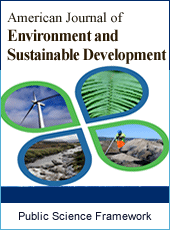American Journal of Environment and Sustainable Development
Articles Information
American Journal of Environment and Sustainable Development, Vol.4, No.3, Sep. 2019, Pub. Date: Oct. 11, 2019
Polyaromatic Hydrocarbons and Metals in Soil Contaminated with Spent Oil Found at Automobile Workshops in Akure, Nigeria
Pages: 101-106 Views: 2098 Downloads: 384
[01]
Isaac Olatunde Awonyemi, Central Research Laboratory, The Federal University of Technology, Akure, Nigeria.
[02]
Adedayo Oyebanji, Department of Chemistry, Joseph Ayo Babalola University, Ikeji Arakeji, Nigeria.
[03]
Temitope Esther Olabiran, Central Research Laboratory, The Federal University of Technology, Akure, Nigeria.
[04]
Micheal Busayo Olajide, Central Research Laboratory, The Federal University of Technology, Akure, Nigeria.
[05]
Johnson Oluwasola Agbede, Central Research Laboratory, The Federal University of Technology, Akure, Nigeria.
Soil samples from different automobile workshops and one control sample obtained from a residential area in Akure, Nigeria were quantified for heavy metals and polycyclic aromatic hydrocarbon. The heavy metals analyzed in all samples were Lead (Pb), Cadmium (Cd), Nickel (Ni), Manganese (Mn), Chromium (Cr), Zinc (Zn) and Copper (Cu). Cadmium (Cd) was obtained was below the level of detection in all samples. Manganese was found to have the highest concentration in all samples with concentration of 614.00mg/kg, 560.00mg/kg and 199.00mg/kg with government accredited site having the highest of 614.00mg/kg and the control sample with the lowest concentration of 199.00mg/kg. The concentration of Ni was found to have the lowest value which is 9.00mg/kg, 7.07mg/kg and 2.90mg/kg in all sites when compared with other heavy metals. Control Sample has the lowest concentration for Pb, Ni, Mn and Cu except for Zn which is of the same concentration with an automobile workshop own by an individual. Eight (8) polycylic aromatic compound which are cyclohexane, (1, 2, 2,-tri fluorine, antracene, phenanthrene, fluoranthene, pyrene, benz (a) anthracene, were found in all soil samples.
Pyrolytic Process, Pollutants, Carcinogenic, Automobile Workshop
[01]
Harvey, R. G. (1991). Polycyclic aromatic hydrocarbon chemistry and carcinogenic. Cambridge University press.
[02]
Sexton, K., Sahmas, J. J., MacDonald, T. J., Gowen, R. M. Z., Miller R. P., McCormick, J. B. and Fisher-Hosh, S. P. (2011). PAHs in Maternal Unbilical cord blood from pregnant Hispanic women living in Brownsville, Texas, International Journal Environmental Research and Public Health Vol. 8, No. 8, pp. 3365–3379, 2011.
[03]
Hati, S. S., Dinar, G. A., Egwu, G. O. and Ogunbuaja, V. O. (2009). Polycyclic Aromatic Hydrocarbons (PAHs) contamination of synthetic industrial essentials utilized in the Northern Nigeria. African Journal of Pure and Applied Chemistry, Vol. 3, No. 5, pp. 86-9.
[04]
Prycek. J, Ciganek, M. and Srinek, Z., (2007). Cleanup of extracts for nitrated derivatives of polycyclic aromatic hydrocarbons analysis prior their gas chromatography determination, Journal Brazilian Chemical Society, 18, 2007, 1125–1131.
[05]
Harvey, R. G. (1997). Polycyclic aromatic hydrocarbons (New York. Wiley Publishers. (667)
[06]
Boehm, P. D., Loreti, C. P., Rosenstein, A. B and Rury, P. M. (2002). A guide to polycyclic aromatic hydrocarbons for the Non-specialist. American Petroleum Institute, Washington D, C. Special publication Number 4714: 54.
[07]
Chen, S. C and Liao, C. M. (2006). Health Risk Assessment on Human Exposed to Environmental Polyaromatic Hydrocarbons pollution sources. Science of the total environment. 366: 112-123.
[08]
Glenn, A. R (1995); Activated carbon applications in the food and pharmaceutical industries, CRC press. pp125
[09]
Mirsal, I. A; Soil pollution, origin, monitoring and remediation, second edition (Springer-Verlag, Berlin, 2004).
[10]
Ana Carolina Agnello (2014), Potential of alfalfa for use in chemically and biologically assisted phytoremediation of soil co-contaminated with petroleum hydrocarbons and metals; sous la direction de Michel Madon. Thèse de doctorat: Sciences et Techniques de l'Environnement: Paris Est.
[11]
Useh M. U., Etuk-Udo G. A., and Dauda M. S., (2015). Evaluating the Physico-chemical Properties and Heavy Metals in Soils of Municipal Waste Dumpsites at Kubwa, Abuja, Nigeria. Journal of Chemistry and Chemical Sciences, 5: 654-662.
[12]
Hreniuc M., Coman M., and Cioruţa B., (2015). Consideration regarding the soil pollution with oil products in Sacel Maramures. International Conference of scientific paper AFASES. Brasov: 28-30.
[13]
Anoliefo GO, Vwioko DE (2001). Tolerance of chromolema odorota (L.) K and R grown in soil contaminated with spent lubricant oil. J. crop Biosci. 1: 20-24.
[14]
Kabata-Pendias A., Piotrowska M., Motowic- Ka-Terelak T., Maliszewska-Kordybach B., Fi- Lipiak K., Krakowiak A., Pietruch Cz. Guidelines for assessment of soil contamination - heavy metals, Sulphur and PAHs. Biblioteka Monitoringu Srodowiska, Warszawa 1995 (in Polish).
[15]
Chiroma T. M.; Ebewele R. O and Hymore F. K., (2014) Comparative Assessment of Heavy Metal levels in soil, vegetables and urban grey waste water used for irrigation in Yola and Kano, International Refereed Journal of Engineering and Science (IRJES) ISSN (online) 2319-183X (print) 2319-1821 Volume 3, Issue 2 (February 2014), pp. 01-09
[16]
Oguntimehin Ilemobayo and Ipinmoroti Kolad. e (2008). Profile of Heavy Metals from Automobile Workshops in Akure, Nigeria. Journal of Environmental Science and Technology, 1 (1): 19-26.

ISSN Print: Pending
ISSN Online: Pending
Current Issue:
Vol. 6, Issue 4, December Submit a Manuscript Join Editorial Board Join Reviewer Team
ISSN Online: Pending
Current Issue:
Vol. 6, Issue 4, December Submit a Manuscript Join Editorial Board Join Reviewer Team
| About This Journal |
| All Issues |
| Open Access |
| Indexing |
| Payment Information |
| Author Guidelines |
| Review Process |
| Publication Ethics |
| Editorial Board |
| Peer Reviewers |


